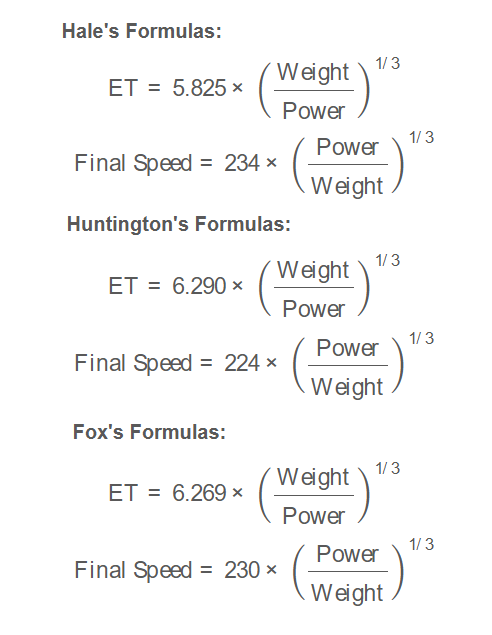 Home
Home
 Back
Back

Definition: This calculator estimates the elapsed time and final speed of a vehicle over a 1/4-mile distance based on its power and weight, commonly used in drag racing.
Purpose: It helps car enthusiasts and racers predict drag strip performance, aiding in vehicle tuning and race preparation.
The calculator uses three empirical formulas, selectable by the user:
Huntington’s Equations: \[ ET = 6.290 \times \left(\frac{W}{P}\right)^{1/3}, \quad v = 224 \times \left(\frac{P}{W}\right)^{1/3} \] Fox’s Equations: \[ ET = 6.269 \times \left(\frac{W}{P}\right)^{1/3}, \quad v = 230 \times \left(\frac{P}{W}\right)^{1/3} \] Hale’s Equations: \[ ET = 5.825 \times \left(\frac{W}{P}\right)^{1/3}, \quad v = 234 \times \left(\frac{P}{W}\right)^{1/3} \] Where:
Unit Conversions:
Steps:
Calculating quarter-mile performance is crucial for:
Example: For a Mercedes W10 Formula One car with power \(P = 975 \, \text{hp}\), vehicle weight 1638 lb (743 kg), and driver weight 150 lb (total \(W = 1788 \, \text{lb}\)):
Q: What is elapsed time in a quarter-mile race?
A: Elapsed time (ET) is the time taken to cover a 1/4-mile distance from a standstill, calculated using one of the three equations based on power and weight.
Q: What is trap speed?
A: Trap speed is the vehicle’s speed at the end of the 1/4-mile, calculated using the selected equation.
Q: How accurate are these calculations?
A: The formulas are empirical and provide estimates based on power and weight. Real-world factors like tire grip, aerodynamics, and track conditions may affect results.